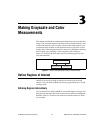Chapter 2 Getting Measurement-Ready Images
IMAQ Vision for Visual Basic User Manual 2-12 ni.com
2. Improve the image in the frequency domain with a lowpass or highpass
frequency filter. Specify which type of filter to use with
CWIMAQVision.CxAttenuate or CWIMAQVision.CxTruncate.
Lowpass filters smooth noise, details, textures, and sharp edges in an
image. Highpass filters emphasize details, textures, and sharp edges in
images, but they also emphasize noise.
• Lowpass attenuation—The amount of attenuation is directly
proportional to the frequency information. At low frequencies,
there is little attenuation. As the frequencies increase, the
attenuation increases. This operation preserves all of the zero
frequency information. Zero frequency information corresponds
to the DC component of the image or the average intensity of
the image in the spatial domain.
• Highpass attenuation—The amount of attenuation is inversely
proportional to the frequency information. At high frequencies,
there is little attenuation. As the frequencies decrease, the
attenuation increases. The zero frequency component is removed
entirely.
• Lowpass truncation—Specify a frequency. The frequency
components above the ideal cutoff frequency are removed, and
the frequencies below it remain unaltered.
• Highpass truncation—Specify a frequency. The frequency
components above the ideal cutoff frequency remain unaltered,
and the frequencies below it are removed.
3. To transform the image back to the spatial domain, use
CWIMAQVision.InverseFFT.
Complex Image Operations
CWIMAQVision.ReplaceComplexPlane and
CWIMAQVision.ExtractComplexPlane allow you to access, process,
and update independently the magnitude, phase, real, and imaginary
planes of a complex image. You can also convert a complex image to
an array and back with
CWIMAQImage.ImageToArray and
CWIMAQImage.ArrayToImage.


















